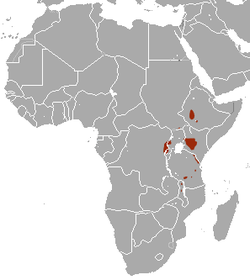| Long-haired fruit bat | |
|---|---|
 | |
| Scientific classification | |
| Kingdom: | Animalia |
| Phylum: | Chordata |
| Class: | Mammalia |
| Order: | Chiroptera |
| Family: | Pteropodidae |
| Subfamily: | Rousettinae |
| Tribe: | Stenonycterini Nesi et al, 2012 |
| Genus: | Stenonycteris Thomas, 1906 |
| Species: | S. lanosa |
| Binomial name | |
| Stenonycteris lanosa (Thomas, 1906) | |
 | |
| Long-haired rousette range | |
The long-haired fruit bat (Stenonycteris lanosa), also known as the long-haired rousette, is a species of megabat in the family Pteropodidae. It is the only member of the genus Stenonycteris. It was formerly classified in the genus Rousettus until a 2013 phylogenetic study found it to belong to its own genus and tribe. [2]
It is native to the Democratic Republic of the Congo, Ethiopia, Kenya, Malawi, Rwanda, South Sudan, Tanzania, and Uganda. Its natural habitat is subtropical or tropical moist montane forests. [1]
